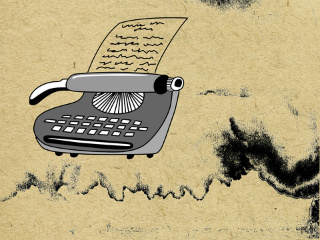My state writing group had a Zoom meeting today at lunch where we discussed writing dialogue. One of the things the host asked was “What are some things writers do with dialogue that you hate?”

Here are some of the “Don’ts” we came up with for writing dialogue:
- Don’t name-call: In real life, people don’t go around calling each other by name every sentence or two. “Hello, Donna,” is fine, but having two people constantly call one another by name is something you’ll never hear in real life.
- Don’t repeat: If you find your characters keep saying the same thing or similar things over and over throughout your work, find a way to cut most or all of them out. Either say what needs to be said once, or figure out something else for that character to talk about.
- Don’t ramble: If your dialogue goes on more than a paragraph or two, it’s time to cut that character off. You don’t want a lecture.
- Don’t use adverbs: You’ve all cringed at these. “She said enthusiastically,” “He exclaimed excitedly,” “They chorused angrily.” Show emotion instead of trying to tell with adverbs.
- Don’t include everything: Real dialogue can be boring. “How are you today?” “Fine, and you?” “Good. How about those Dodgers?” Get to the meat of the conversation and leave out anything else.
- Don’t say what’s already known: “As you know, Bob …” If your character already knows how a cellphone works, they’re not going to strike up a random conversation explaining it to someone else.”
- Don’t have talking heads: Real people don’t just sit there talking. They do things. They fidget. They walk and talk. Give your characters actions. Not only will it be more interesting, but you can move the plot along more quickly that way.
- Don’t write grammatically: Real people also don’t speak in grammatically correct, perfect sentences. They use fragments. They use dialect (see the next two “Don’ts” however!). They hem and haw.
- Don’t overuse dialect: It’s fine if you have a character from the South. However, don’t go overboard trying to spell out every word they say. That gets old fast. Simply sprinkle in a few dialect choices, then the readers remember that Joe speaks in a Southern drawl.
- Don’t use the wrong dialect: If your character is Irish, make sure they’re not actually speaking in a Scot’s brogue. If you don’t actually know a person with that specific dialect, go online and advertise for some beta readers. Get expert advice before you make a mistake.
You can probably think of more “pet peeves” about dialogue, but these seem to be the main ones to avoid. What makes you cringe when you read it?
I’m nearly done with my second re-write of the book, and it’s time to think about editing again. How do you edit your own work, and when do you know that you’re finished editing and ready to send the work out to the agent or editor?
Rules for Editing:
- Print out your manuscript. Somehow, it’s easier to edit if you have the paper in front of you. You can write notes in the margins, circle things you want to change, and even read from back to front when you need to. If you can’t print, at least use the “Track Your Changes” feature of your word processing software.
- Make passes. I’ll explain each one below, but the idea is that, with each pass, you are concentrating on only one aspect instead of trying to edit everything at once.
- Edit without rewriting. It’s really tempting to start rewriting as soon as you spot an error, or a place you want to add something – but resist the urge. Finish your edits, then start rewriting.
- First Pass: Read through the entire manuscript, looking for only spelling and grammatical errors. If you happen to catch something else that seems wrong, just make a note in the margin and keep going. You may choose to rewrite at this point, or just swing right into the next pass.
- Second Pass: Read through the entire manuscript again, this time looking for word choice and clarity. One great trick to catch poor word choices is to read the manuscript from back to front. This forces you to concentrate on each word, not on the total sentence. Rewrite at this point, where needed.
- Third Pass: Read through the manuscript for continuity. Make sure that any actions make sense, that all of the loose ends are tied up, and that any “props” brought into a scene are used properly. Just as a continuity checker in a movie or TV show checks to be sure everything is still in the correct place, you need to be sure that the pistol your character shoots in Chapter 7 was properly introduced in Chapter 2, when you showed us the gun cabinet in the study. Make notes in the margin and keep track of everything you’ve introduced to be sure it’s used. Rewrite after this pass, adding any necessary scenes or dialogue.
- Fourth Pass: Read through the dialogue. Make sure each line is spoken in the unique voice of the character, and that each line advances the plot in some manner. If it doesn’t move the plot, expand the character, or deepen the setting, then drop that line. Use something else, or drop the conversation entirely if it’s not doing anything. Rewrite after this pass.
- Fifth Pass: Yes, you might need one. If you’ve done extensive rewriting, you’re going to want to start editing again on those sections, checking for everything you’ve checked the rest of the manuscript for.
How do you know when you’ve finished editing? Most authors agree that when you reach the point where you’re changing only around 10% of the manuscript, you’re through. Stop fiddling with the thing and send it out!
Everybody knows what dialogue is. You read it all the time, in every fiction book you pick up. You hear it on TV and in the movies. It’s obvious … isn’t it?
Not really. Writing dialogue is more involved than most beginning writers think it is. It’s not just a matter of slapping down a few lines of speech. Here are five myths about dialogue — and the truth for each one.
1. Good dialogue uses plenty of synonyms for “he said.” Many writers believe that they need to come up with a unique dialogue tag for each line, such as “he exclaimed” or “she hissed.” The truth is, good dialogue seldom uses more than the occasional “he said” or “she asked” — and that’s only when clarification is absolutely needed. Readers skim over those familiar words, and read only the spoken lines. When they hit one of those oddball synonyms, they’re jarred right out of the story trying to figure out what the character was doing. Especially jolting are terms like “he smiled” or “she grimaced” — actions you don’t normally associate with speech at all. Just stick to the old stand-by and your readers will thank you.
2. You need a dialogue tag for every line of speech. Your readers are pretty clever people. They know that when two people are talking, they’ll typically take turns speaking, so every other line will be another person. The truth is, you almost never have to write “he said” or “she asked” at all. Start the ball rolling with the primary character doing something, then just slip in their dialogue. The reader will pick it up at that point and understand that the next line belongs to the second person. Show the action, and you can skip the tags. At most, you’ll just have to stick in the odd “Bob said” or “Sally replied” once in a while.
3. Just write the way the average person speaks. Nobody would read past the third line of dialogue if you did this! Dialogue is not just a transcription of normal speech. Most people do a lot of hemming and hawing, with plenty of “ums” and “ers” and “uhs” thrown in. People blather a bit as well, asking about your health and the family and talking about the weather. Nobody wants to read all that! Condense your dialogue to the main information and skip all the small talk.
4. Show dialect phonetically. This seems reasonable on the surface. After all, a character from Ireland will speak a different dialect than one from China. However, phonetic spelling is hard to read, and you end up jolting the reader out of the story again as they try to puzzle out what the character is saying. The best way to handle dialect is to show one — two at the most — examples of phonetic spelling to give the readers the idea. From that point, you need only phrase the speech in the proper manner to remind them. Throw in a few recognizable slang terms, for example, or show the stilted speech of a non-English speaker. Otherwise, use standard spelling and let the reader “translate” into dialect in their own head.
5. Give the whole dialogue. Many writers don’t seem to know when to describe and when to use dialogue. They include the small talk, the greetings and farewells, and all the little boring things people normally include in a conversation. The beauty of writing is that you can skip all the boring stuff and get right into the meat of a dialogue. Show the characters coming together — you don’t need the greetings, the remarks about the local sports team, or the catching-up on the family members. Start the dialogue when the meat of the conversation is reached, and stop as soon as the relevant information is conveyed. The readers can fill in the rest (if they even want to).
What are some of the worst examples of dialogue you’ve ever read?
HERE’S a nice link to go with yesterday’s dialogue tips – 10 Easy Ways to Improve Dialogue!
Writers are incurable eavesdroppers — and we should be. It’s our job to create believable characters, and in order to create, you have to understand. Thus, we spend a great deal of time listening to real characters interact.
Never let an opportunity pass you by. Pay attention to those two old ladies behind you in the check-out line as they complain about their ungrateful grandchildren. Prick up your ears as the couple at the next table discusses their finances over dinner. Sit back in a corner of the mall and absorb.
But you’re not just collecting gossip when you eavesdrop. Here’s what you should be listening for:
- Rhythm – people don’t deliver information in packets, like an encyclopedia or computer program. Conversation ebbs and flows, and you must pay attention to catch the rhythm of the speech. Rhythm can be a regional trait as well, so familiarize yourself with the cadence of local conversation as you listen. A New Yorker, for example, will speak in a more rapid, brusque manner when compared to a South Carolinian.
- Tone 1 – the attitude or emotion of the speaker. This can be freely expressed or hidden, so you must pay attention to body language in addition to words. But that’s a subject for a later article.
- Tone 2 – when conversation is emotionally charged, people speak in a higher tone of voice than when they are relaxed. Emotion tightens the vocal cords. Professional speakers utilize a lower, relaxing tone. Think Morgan Freeman.
- Diction – word choice. This is unique to every speaker. Educated people use longer, more vivid words, while uneducated people use simpler words. Regional dialect plays a part as well, especially with the uneducated speaker.
- Sentence Length – educated people usually use longer sentences than uneducated people. Shorter sentences can also signal tension or urgency. People also tend to shorten or abbreviate their sentences in informal situations.
- Syntax – the way words are arranged within sentences. English typically uses a subject-verb-object order, for example. Non-English speakers often give themselves away with syntax as well as word choice.
The art of eavesdropping, you can see, is a bit more complicated than it seems. Or it is if you’re a writer looking for material.
What’s your best eavesdropping technique?
I think I have finished the poker story for the Wolf Creek anthology. Notice the operative word “think.” Sometimes it’s hard to know when you’ve really finished something.
I had some trouble with this story, so I thought I’d share the journey with you. Every writer can benefit from another writer’s trials, right?
To start with, this is the first time I’ve submitted to another editor’s anthology in years. I’m nervous about whether they’ll even accept the thing. I started over about five times – trying different openings, starting at different points in the story, having Kye and Chance do different things. I like to begin in the middle of the action, so I usually start with them either in the middle of an argument, or in the middle of some sort of struggle. This time, I opted for argument, then “panned out” to show where they were and why they were fighting.
I tried for a spare, stripped-down story when I usually prefer the more descriptive style – there’s a word limit for the anthology. This was another difficulty. How sparse is too sparse? You do need some backstory, some description, if your readers are going to see the images in their heads.
Then there’s the last sentence. I usually end with something indicative of the character’s personality. As I usually write from Chance’s POV, this means the end is usually something snarky or sneaky or tricky. I had some trouble finding the perfect line this time, and I’m still not as confident in the one I picked as I usually am.
I’ve cut about as much as I’ve kept, too. I deleted whole scenes, dropped dialogue that was going nowhere, cut redundant words and phrases. I have tried to be ruthless, though this is hard with your own writing sometimes. You get so close that you can’t really see the whole work any longer, so it’s hard to tell what’s integral to the plot and what isn’t.
This is why I rely on my “beta readers.” Always pass your work by at least one friend or family member who will give you an honest critique. You don’t want “I loved it” or “It’s great” here. You want someone to say “This part didn’t work for me and here’s why,” or “You can get rid of this part because it doesn’t do anything for the story.” Find a Grammar Nazi to check your sentence structure and word choice – those spell-check programs can’t decide if you’ve used the totally wrong word or mixed your tenses.
I’m at that stage now – the story is out to the beta readers and I’m waiting for their judgement. Then one final edit, some finger-crossing and maybe a little prayer, and it’s off to the editors.
Do you have any particular stories that were really difficult for you? What made them hard to write?
I’ve spent a lovely three days hob-nobbing with other authors and attending writing panels. Here are some gems from the classes.
- The day I stop learning about my characters is the day I become bored with them — Margaret Coel
- Good beginnings and endings are like good art: I know it when I see it, but it’s awfully hard to define — Jamie McGrath Morris
- One of the biggest dialogue mistakes I see is when all the characters sound alike — Craig Johnson
- Write the kind of novel that, once the reader picks it up, he cannot bear to put it down; not the kind of novel that, once he puts it down, he cannot bear to pick it back up — Margaret Coel
- Before you even sit down to write, know — in this order — what the ending is, and what the beginning will be — Kirk Ellis
- Writing is not a profession, but a vocation. Think bigger than just a contract, a published book. Ask yourself ‘Is this worth one to three years of my life?’ before you begin that novel — David Morrell
- Try this: gather a stack of award-winning novels and read the ending first. Then, read the book to see how the author gets from Point A to Point Z. Do that 500 times. Can you imagine how much you’ll learn about the art of plotting? — Steve Havill
- Here’s a big secret: have someone read your dialogue back to you — Craig Johnson
- ‘Let me tell you a story’ is a very powerful lure — Jamie McGrath Morris
- It’s never as good as it could be. And ‘spoiler alert:’ it’s never going to be — Kirk Ellis
- Become a student of human nature — Craig Johnson
What is the best advice you’ve ever heard from another writer?
For some writers, dialogue flows easily onto the page; for others, it’s an agonizing battle to find just the right words. Here are some tips for writing convincing dialogue.
- Know your characters. If you haven’t already filled out one of those character background charts, at least consider the educational level and basic history of each character. Know what sort of language they’d use. Are they well-educated, using longer words and sentences with correct grammar? Are they less-educated, with shorter words and sentences, and possibly with poor grammar? Do they use idioms and slang particular to a certain area? Are they talkative, or do they say only what’s necessary? Knowing your characters is the first step toward giving them convincing dialogue.
- Use individual voices. Each main character should have a unique speaking style based on their history and education. This should be plain enough that the reader could identify a speaker without any dialogue tags (“Tom said” or “Sally asked”). Once you’ve learned all about your characters, this will be much easier, and they’ll develop their own style of speaking.
- Avoid the thesaurus. Beginning writers often try to come up with variations on “he said” or “she asked.” Don’t. Words like “queried,” “hissed,” “exclaimed,” or even (OMG) “ejaculated” jerk the reader right out of the story (and perhaps off in search of a dictionary) and defeat your primary purpose as a writer. If you must use a tag, go with “said” or “asked.” The reader will skim over those words and keep reading, which is what you want.
- Keep the dialogue tags to a minimum. If you have only two speakers, you can skip the tags altogether and have a back-and-forth dialogue with only the occasional “Joe said” to remind the reader who’s speaking. If you’ve followed Step 2, even that will be unnecessary, as each character’s unique voice will make it obvious which one is speaking.
- Skip the tags entirely. One great way to indicate speaker without using tags is to use action. Show the characters moving and reacting instead of telling that they’re speaking. You don’t need “he said” if you start the paragraph with Jeff pounding a fist on the table in frustration, or split the dialogue to show Mary dabbing tears of laughter from her eyes.
What about you? Do you find dialogue easy or difficult? What are some tips you’ve learned?





